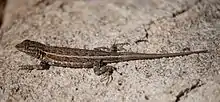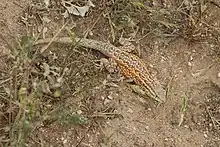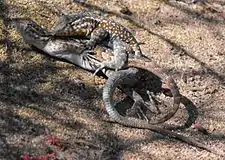Common side-blotched lizard
The common side-blotched lizard (Uta stansburiana) is a species of side-blotched lizard in the family Phrynosomatidae. The species is native to dry regions of the western United States and northern Mexico. It is notable for having a unique form of polymorphism wherein each of the three different male morphs utilizes a different strategy in acquiring mates. The three morphs compete against each other following a pattern of rock paper scissors, where one morph has advantages over another but is outcompeted by the third.[1][2][3]
| Common side-blotched lizard | |
|---|---|
 | |
| Scientific classification | |
| Kingdom: | Animalia |
| Phylum: | Chordata |
| Class: | Reptilia |
| Order: | Squamata |
| Suborder: | Iguania |
| Family: | Phrynosomatidae |
| Genus: | Uta |
| Species: | U. stansburiana |
| Binomial name | |
| Uta stansburiana | |
| Subspecies | |
| |
 | |
| Synonyms | |
| |
Etymology
The specific epithet, stansburiana, is in honor of Captain Howard Stansbury of the US Corps of Topographical Engineers, who collected the first specimens while leading the 1849-1851 expedition to explore and survey the Great Salt Lake of Utah.[4][5]
Systematics

The systematics and taxonomy of the widespread and variable lizards of the genus Uta is much disputed.[6][7] Countless forms and morphs have been described as subspecies or even distinct species.[8]
- The forms which occur in most of Mexico (except Baja California) have been recognized as a very distinct species, the eastern side-blotched lizard (Uta stejnegeri).[9]
- Populations from San Benito and Cedros Islands were separated as distinct species Uta stellata and U. concinna, but are now included in U. stansburiana.
- Those of Isla Santa Catalina and Isla Salsipuedes, U. squamata and U. antiqua are sometimes included in this species, too, but this is certainly not correct in the latter case, and probably in the former also.
- Based on the same data that would give U. squamata species rank, the southern Baja California populations could arguably be split off (as Uta elegans), too.
- The proposed subspecies martinensis and taylori are probably not valid.
- The populations on Isla Ángel de la Guarda, Isla Mejia and Isla Rasa almost certainly constitute a separate species closer to Uta palmeri, and that of San Esteban Island may so too, being close to squamata.
- The status of the Isla Encantada group populations named as Uta encantadae, U. lowei and U. tumidarostra is not completely resolved; these distinct populations are of comparatively recent origin and are sometimes included in this species, but their unique adaptations to living in intertidal habitat suggest they should be considered distinct; whether as one or as three species remains unresolved.[10]

Description
The common side-blotched lizard is a species of small iguanid lizard. Males can grow up to 60 mm (2.4 inches) from snout to vent, while females are typically a little smaller. The degree of pigmentation varies with sex and population. Some males can have blue flecks spread over their backs and tails, and their sides may be yellow or orange, while others may be unpatterned. Females may have stripes along their backs/sides, or again may be relatively drab. Both sexes have a prominent blotch on their sides, just behind their front limbs.[12] Coloration is especially important in common side-blotched lizards, as it is closely related to the mating behavior of both males and females.[1][13]
Ecology and behavior
Rock paper scissors mechanism
Male side-blotched lizards exhibit distinct polymorphism in their throat colors, and can be divided into three different categories. Each of these three different morphs varies in how it competes for mates, and variation within a breeding population is maintained by a rock paper scissors mechanism of frequency-dependent sexual selection. A cycle is created where the least common morph of one breeding season often has the largest number of mature living offspring in the next year. This is because one morph does particularly well against another, but poorly in comparison to the third.[1]
- Orange-throated males are "ultradominant." They are the largest and most aggressive morph, defending relatively large (about 100 m2 or 120 yd2) territories and keeping harems of females with which they mate. They are adept at stealing mates from blue-throated individuals, but are vulnerable to cuckoldry by the yellow-throated female mimics.[1] Orange-throated males also have significantly reduced yearly survival rates compared to the other two morphs.[14]
- Blue-throated males are "dominant". They are intermediate in size, and guard smaller territories containing only a single female. As they only have one mate to defend, they are better at catching yellow-throated sneaks, but are also susceptible to having their mates stolen by the larger, more aggressive orange-throated males.[1]
- Yellow-throated males are “sneakers”. Their coloration is similar to that of sexually mature females, and they typically mimic female “rejection” displays when they encounter dominant orange- or blue-throated males. Unlike the other morphs, yellow-throated males do not hold territories. Instead, they have wide-reaching home ranges that may overlap with several other lizards’ territories.[1][14] They rely on their mimicry to sneak matings with unattended females. This is more easily achieved among the harems kept by orange-throated males than by the single, closely guarded mate of the blue-throated males. Though orange-throated males have the highest mortality rates, yellow-throated males have higher relative rates of posthumous fertilization (posthumous birth), indicating an increased reliance on sperm competition as part of their reproductive strategy.[2] Yellow-throated males can in specific instances transform into blue-throated males over the course of the breeding season. This transformation is usually triggered by the death of a nearby dominant male, and the blue patches the yellow-throated males develop is qualitatively distinct from the blue patches of genetically blue-throated males. Not all yellow-throated males transform, but when they do, they give up their female mimicry and adopt the “dominant” morph's behavior pattern. No transformations in the other direction, in which dominant males gain yellow-throat coloration, have been observed.[14]
Female side-blotched lizards have also been shown to exhibit behaviorally correlated differences in throat coloration. Orange-throated females are considered r-strategists. They typically produce large clutches consisting of many small eggs. In contrast, yellow-throated females are K-strategists that lay fewer, larger eggs. Like the male morphs, the frequencies of these two female morphs also cycle with time. However, the cycle is shorter – two years in comparison to the male morphs’ four- or five-year cycle – and is not a result of frequency-dependent sexual selection. Instead, orange-throated females are more successful at lower population densities, where competition for food is less fierce and less selection pressure from predation occurs.[13] When population density is high and or when predators abound, yellow-throated females tend to have higher reproductive success. In general, their larger hatchlings have higher short-term and long-term survival rates, and these advantages are magnified in times of scarcity. Side-blotched lizards show displays and aggression shortly after hatching, and even minute differences in size can lead to increased social dominance and capacity to outcompete the smaller hatchlings.[15]
Genetic determination of throat-color polymorphism
Analysis of DNA nuclear microsatellites has provided genetic evidence for the rock-paper-scissors behavior pattern of male side-blotched lizard competition. In populations where all three morphs are present, shared paternity between yellow- and blue-throated individuals occurs at a rate significantly below random chance, while shared paternity between yellow- and orange-throated males occurs at a rate significantly above chance. In addition, blue-throated males often shared paternity with orange-throated males, despite having mostly yellow-throated neighbors.[2]
Blood plasma testosterone levels play an important role in the creation of the three male morphs both during and after development. Orange-throated males have 46-48% higher plasma testosterone levels compared to their yellow- or blue-throated counterparts. Experimental elevation of plasma testosterone levels in the other two male morphs led to increases in endurance, aggressiveness, and territory size to the degree expressed by normal orange-throated males. In addition, the transformation of yellow-throated males to blue-throated males is accompanied by an increase in their plasma testosterone levels.[14]
Throat color in side-blotched lizards is genetically determined, and has high heritability.[1] It is determined by a single Mendelian factor with three alleles. In males, the o allele is the dominant allele, and the b allele is recessive to the y allele. Therefore, phenotypically orange-throated males have genotypes of either oo, ob, or oy. Yellow-throated males have genotypes of either yy or yb, and blue-throated males are exclusively bb. In females, all individuals with the dominant o allele are orange-throated, while those lacking an o allele develop yellow throats.[13]

Reproduction
Female side-blotched lizards lay clutches with an average of 5.1 eggs and a maximum of 9 eggs in a single clutch. Smaller clutch sizes, often associated with yellow-throated females, have an increased frequency of eggs bursting upon being laid or egg binding, suggesting an upper physiological limit to how much a female can invest in each individual egg she lays.[3]
Aggression and courtship
Dominant male side-blotched lizards are aggressive in the defense of their territories. Upon spotting another conspecific within their territories, resident individuals enter a state of heightened alertness. They perform one or more “pushups” (vertical bobbing motions), arch their backs, and extend their limbs before approaching the intruder.[12] If the intruder is another male, the resident follows up by rushing, butting, or nipping at the intruder, which will then usually proceed to run away. If it is a female, the resident will initiate courtship, which consists of circling, flank-biting, licking, smelling, shallower head-bobbing, and eventually copulation. Body shape and passivity are the main releasers for courtship activity, and males have been observed in trying to court and copulate with smaller lizards of other species, as well as smaller subordinate side-blotched lizards.[16]
Tail length is important in the determination of dominance hierarchies. Like many other lizard species, side-blotched lizards use tail autotomy as an escape mechanism. However, a reduction in tail length also confers a loss of social status for both males and females.[17] Males will autotomize their tails less readily than will females, likely due to the increased importance of social status for males. Subordinate females can still mate, but male reproductive success is directly tied to their social status.[18]
Feeding
Side-blotched lizards display feeding behavior which can be influenced by sex or season. In a study conducted by Best et al.., these lizards were found to consume diets largely based upon arthropod populations within the area, within a given season. These populations vary by year, and different arthropod populations will fluctuate seasonally. The study showed a correlation between sex and diet, giving way to a number of theories that speculate why gender has an effect on feeding behavior and diet. One mechanism proposes the behavior differences depend on gender, such as guarding territories and attracting mates, are responsible for, or a contributing factor in, feeding behavior. Alternatively, the sexual difference in feeding behavior could also act in favor of reducing intraspecific competition for resources, with individuals eating prey appropriate for their respective size (ex. small females consuming smaller prey).[19]
Speciation
The "rock-paper-scissors" mating strategy is a genetically-based male polymorphism that has been maintained over millions of years throughout many populations of side-blotched lizard in the United States and Mexico. However, speciation has resulted from the formation of reproductive isolation between populations when a population loses of one or more of the male morphologies.[20][21] However, speciation due to the loss of a male morph has occurred when populations lose one or more male morphs and become reproductively isolated from populations with the ancestral polymorphism.[22] For side-blotched lizards, the morph lost most commonly is the sneaker male.[22] In other cases, speciation has occurred as a result of hybridization between morphs occurring in response to rapid changes in the environment .[20][23]
The loss of a male morph can change selection on the remaining morphs.[24] In side-blotched lizards, for example, female mate preferences change after the loss of a male morph, and alleles that once allowed other male morphs to outcompete the lost morph for mates are no longer as beneficial.[24] These shifts in selection often lead to greater sexual size dimorphism.[24] Larger male and female size regularly follow the loss of a polymorphism, as seen in the side-blotched lizards.[22] Predator-prey dynamic also change after a male morph is lost, with predators evolving to prey on the remaining morphologies.[24]
Parasites
Like most animals, side-blotched lizards are infected by a variety of parasites. Intestinal parasites include nematodes [25] and cestodes.[26] Blood parasites include members of the Apicomplexa such as Schellackia occidentalis [27] and species of Lankesterella.[28] The tegument is infected by several species of mites.[29] Parasites can alter metabolism and reproductive success of side-blotched lizards due to body temperature changes in response to fighting the infection.[30]
References
- Sinervo, B.; C.M. Lively (1996). "The rock–paper–scissors game and the evolution of alternative male strategies". Nature. 380 (6571): 240–243. doi:10.1038/380240a0. S2CID 205026253.
- Zamudio, Kelly R.; Barry Sinervo (2000). "Polygyny, mate-guarding, and posthumous fertilization as alternative male mating strategies". PNAS. 97 (26): 14427–14432. doi:10.1073/pnas.011544998. PMC 18935. PMID 11106369.
- Sinervo, Barry; Paul Licht (1991). "Proximate Constraints on the Evolution of Egg Size, Number, and Total Clutch Mass in Lizards". Science. 252 (5010): 1300–1302. doi:10.1126/science.252.5010.1300. PMID 17842955. S2CID 37108580.
- Moll, Edward (2005). "Uta stansburiana Baird and Girard, 1852 - Common Side-blotched Lizard". Sonoran Herpetologist.
- Beolens, Bo; Watkins, Michael; Grayson, Michael (2011). The Eponym Dictionary of Reptiles. Baltimore: Johns Hopkins University Press. xiii + 296 pp. ISBN 978-1-4214-0135-5. (Uta stansburiana, p. 251).
- Grismer, L.L. (1994). "Three new species of intertidal side-blotched lizards (Genus Uta) from the Gulf of California, Mexico". Herpetologica. 50: 451–474.
- Upton, Darlene E.; Murphy, Robert W. (1997). "Phylogeny of the side-blotched lizards (Phrynosomatidae: Uta) based on mtDNA sequences: support for midpeninsular seaway in Baja California". Molecular Phylogenetics and Evolution. 8 (1): 104–113. doi:10.1006/mpev.1996.0392. PMID 9242598.
- Schmidt, Karl Patterson (1921). "New species of North American lizards of the genera Holbrookia and Uta" (PDF). American Museum Novitates. 22: 1–6.
- Collins, Joseph T. (1991). "Viewpoint: a new taxonomic arrangement for some North American amphibians and reptiles" (PDF). Herpetological Review. 22 (2): 42–43. Archived from the original (PDF) on 2007-09-29.
- Murphy, Robert W. & Aguirre-León, Gustavo (2002): The Nonavian Reptiles: Origins and Evolution. In: Case, Ted & Cody, Martin (eds.): A New Island Biogeography of the Sea of Cortés: 181-220. Oxford University Press. ISBN 0-19-513346-3 PDF fulltext Appendices 2-4
- "Western Side-blotched Lizard - Uta stansburiana elegans". California Herps. californiaherps.com. 2018. Retrieved 2018-08-07.
- Tinkle, D.W. (1967). "The life and demography of the side-blotched lizard, Uta stansburiana". University of Michigan Museum of Zoology: Miscellaneous Publications (132).
- Alonzo, S.H.; Barry Sinervo (2001). "Mate choice games, context-dependent good genes, and genetic cycles in the side-blotched lizard, Uta stansburiana". Behavioral Ecology and Sociobiology. 49 (2–3): 176–186. doi:10.1007/s002650000265. S2CID 23799664.
- Sinervo, Barry; Donald B. Miles; W.Anthony Frankino; Matthew Klukowski; Dale F. DeNardo (2000). "Testosterone, Endurance, and Darwinian Fitness: Natural and Sexual Selection on the Physiological Bases of Alternative Male Behaviors in Side-Blotched Lizards". Hormones and Behavior. 38 (4): 222–233. doi:10.1006/hbeh.2000.1622. PMID 11104640. S2CID 5759575.
- Ferguson, Gary W.; Stanley F. Fox (1984). "Annual Variation of Survival Advantage of Large Juvenile Side-Blotched Lizards, Uta stansburiana: Its Causes and Evolutionary Significance". Evolution. 38 (2): 342–349. doi:10.2307/2408492. JSTOR 2408492. PMID 28555919.
- Ferguson, Gary W. (1966). "Releasers of courtship and territorial behaviour in the side blotched lizard Uta stansburiana". Animal Behaviour. 14 (1): 89–92. doi:10.1016/S0003-3472(66)80015-5. PMID 5918254.
- Fox, Stanley F.; Nancy A. Heger; Linda S. Delay (1990). "Social cost of tail loss in Uta stansburiana: lizard tails as status-signalling badges". Animal Behaviour. 39 (3): 549–554. doi:10.1016/S0003-3472(05)80421-X. S2CID 53179644.
- Fox, Stanley F.; Jason M. Conder; Allie E. Smith (1998). "Sexual Dimorphism in the Ease of Tail Autotomy: Uta stansburiana with and without Previous Tail Loss". Copeia. 1998 (2): 376–382. doi:10.2307/1447431. JSTOR 1447431.
- Best, Troy L.; A. L. Gennaro (September 1984). "Feeding Ecology of the Lizard, Uta stansburiana, in Southeastern New Mexico". Journal of Herpetology. 18 (3): 291–301. doi:10.2307/1564083. JSTOR 1564083.
- Gray, Suzanne M.; McKinnon, Jeffrey S. (2007-02-01). "Linking color polymorphism maintenance and speciation". Trends in Ecology & Evolution. 22 (2): 71–79. doi:10.1016/j.tree.2006.10.005. ISSN 0169-5347. PMID 17055107.
- Corl, Ammon; Lancaster, Lesley T.; Sinervo, Barry (December 2012). "Rapid Formation of Reproductive Isolation between Two Populations of Side-Blotched Lizards, Uta stansburiana". Copeia. 2012 (4): 593–602. doi:10.1643/CH-11-166. ISSN 0045-8511. S2CID 86230966.
- Corl, Ammon; Davis, Alison R.; Kuchta, Shawn R.; Sinervo, Barry (2010-03-02). "Selective loss of polymorphic mating types is associated with rapid phenotypic evolution during morphic speciation". Proceedings of the National Academy of Sciences. 107 (9): 4254–4259. doi:10.1073/pnas.0909480107. ISSN 0027-8424. PMC 2840131. PMID 20160090.
- Wellenreuther, Maren; Svensson, Erik I.; Hansson, Bengt (2014). "Sexual selection and genetic colour polymorphisms in animals". Molecular Ecology. 23 (22): 5398–5414. doi:10.1111/mec.12935. ISSN 1365-294X. PMID 25251393. S2CID 5504865.
- McLean, Claire A.; Stuart‐Fox, Devi (2014). "Geographic variation in animal colour polymorphisms and its role in speciation". Biological Reviews. 89 (4): 860–873. doi:10.1111/brv.12083. ISSN 1469-185X. PMID 24528520. S2CID 4664660.
- Lyon, R. E. (1986). Helminth parasites of six lizard species from southern Idaho. Proceedings of the Helminthological Society of Washington, 53(2), 291-293. PDF
- Bursey, C. R.; Goldberg, S. R. (1996). "Oochoristica macallisteri sp. n. (Cyclophyllidea: Linstowiidae) from the side-blotched lizard, Uta stansburiana (Sauria: Phrynosomatidae), from California, USA" (PDF). Folia Parasitologica. 43: 293–296.
- Bonorris, Jim S.; Ball, Gordon H. (1955). "Schellackia occidentalis n.sp., a blood-inhabiting coccidian found in lizards in Southern California". Journal of Protozoology. 2 (1): 31–34. doi:10.1111/j.1550-7408.1955.tb02393.x. ISSN 0022-3921.
- Quillfeldt, Petra; Romeike, Tanja; Masello, Juan F.; Reiner, Gerald; Willems, Hermann; Bedolla-Guzmán, Yuliana (2018). "Molecular survey of coccidian infections of the side-blotched lizard Uta stansburiana on San Benito Oeste Island, Mexico". Parasite. 25: 43. doi:10.1051/parasite/2018043. ISSN 1776-1042. PMC 6092949. PMID 30109981.

- Goldberg, Stephen R.; Bursey, Charles R. (1991). "Integumental lesions caused by ectoparasites in a wild population of the side-blotched lizard (Uta stansburiana)". Journal of Wildlife Diseases. 27 (1): 68–73. doi:10.7589/0090-3558-27.1.68. ISSN 0090-3558. PMID 2023329.
- Paranjpe, Dhanashree A.; Medina, Dianna; Nielsen, Erica; Cooper, Robert D.; Paranjpe, Sharayu A.; Sinervo, Barry (2014-07-01). "Does Thermal Ecology Influence Dynamics of Side-Blotched Lizards and Their Micro-Parasites?". Integrative and Comparative Biology. 54 (2): 108–117. doi:10.1093/icb/icu069. ISSN 1540-7063. PMID 24920752.
External links
![]() Media related to Uta stansburiana at Wikimedia Commons
Media related to Uta stansburiana at Wikimedia Commons
- UC Santa Cruz, Cooperation between unrelated male lizards adds a new wrinkle to evolutionary theory (Essay on Sinervo & Clobert 2001 paper)